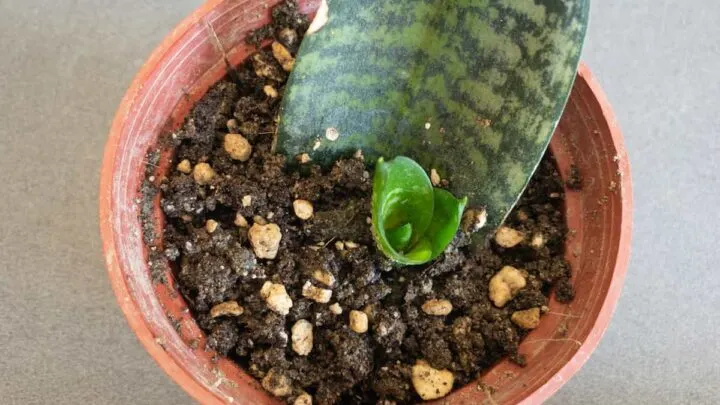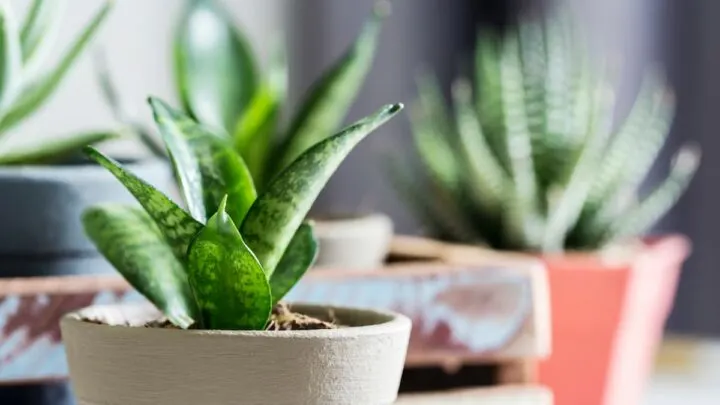Snake plants are known to be easy, tolerant plants with very few requirements other than some sun and some water. Just because they don’t ask for much doesn’t mean we can’t treat them better, starting off with the basics of soil. Soil is the foundation for most plants to anchor themselves in the ground, which allows them to draw water and nutrients from the earth. This brings us to the question: What kind of soil is suitable for snake plants?
Snake plants prefer well-draining, fertile soil with a slightly acidic pH, though they’ll tolerate a neutral pH with little to no issue. A dry soil between 5.5 – 7.0 pH works best for snake plants.
Continue reading to learn more about snake plants’ soil preferences and what you can do to ensure your snake plant thrives.

Soil Basics
As we know, soil is an integral part of a plant’s success that can often be overlooked. Many believe all soil is created equal, though this is not true; one cannot expect a plant suited for coastal environments to thrive in heavy, clay soils and vice-versa.
Soil is essentially the first layer of earth, which varies widely worldwide. Snake plants are native to tropical areas in Africa and have evolved to thrive in dry habitats, often with poor, rocky soil, making do with little water until a downpour comes.
Their fleshy, waxy leaves have adapted perfectly to retain moisture for these times of drought. Compare this to other tropical plants that are not as drought-tolerant, and you can see why not all plants can adapt to the same conditions.
Soil pH is a large part of your plant’s ability to absorb the nutrients locked away in the earth, so ensuring your soil is between 5.5-7.0 on the pH scale is vital to your plant’s success.
Soil pH meters are available to purchase online inexpensively, and it is a useful tool when dealing with different plants. You can give your plants all the water and fertilizer in the world and still have poor growth and development if it has no way to access these resources.
DIY Soil Mixes for Snake Plants
Creating your own soil mix for your plants can be an interesting learning experience and another way to get involved with your plants. If you have many plants with different needs, it might benefit you to begin creating your own mixes out of basic components that most soil mixes will share.
Here are the items you will need to create a mix suitable for all snake plant varieties:
Coarse Sand
Coarse sand or even perlite aids in creating a fast-draining environment. Snake plants have adapted to drought conditions, so they do not like being in wet soils. Adding a well-draining component like horticultural sand allows water to pass through while the other components of the soil are able to retain just enough to keep the plant hydrated until the next watering session.
Orchid bark is another option that can be used if it is already on hand, though sand is more similar to the soil composition in its native environment.
Coco coir or Peat Moss
Coco coir is the fibers from coconut husks that are able to retain water without losing their shape or becoming excessively heavy. Peat moss does the same thing, though it eventually decomposes in the soil and needs to be replaced about once a year.
Using either of these components helps ensure that all the water your plant receives can be retained in a controlled manner and slowly released to your plant when it needs it most.

Soil from your yard (or potting mix)
Soil can be gathered from a healthy part in your yard or a general potting mix. This helps anchor your plant and give its roots something to hold on to, as well as helping to hold water long enough for your plant to use it effectively.
Mix one part each of garden soil and coco coir/peat moss to two parts of coarse sand or perlite. The mix should be aerated and loose in texture, and water should be able to easily pass through the soil promptly to protect your plant from root rot.
Excess soil can be stored in a tote with a lid and used for other similar plants such as cacti and succulents.
What is the Best Soil Mix for Snake Plants?
Pre-mixed soils will not cause a fuss for your plant; after all, snake plants are known for their ease of care and tolerance to neglect. You should always try to give your plant the best conditions, regardless of how easy-going they are. Some good pre-mixed soils are listed below:
Miracle-Gro Cactus Palm and Citrus Potting Mix
This is probably something on-hand if you’re one for growing cacti and succulents. This soil is a good starting point for any succulent-type plant, such as snake plants that need some more drainage than the typical potting mix will afford. It contains sand, perlite, and peat moss, all of which are recommended to aid quick water drainage.
Additionally, this soil has some mixed fertilizer, which should sustain your plant for at least 6 months after potting. The downside to this mix is it is on the edge of the acidity that snake plants prefer, coming in at 5.5-6.2 on the scale. Using this type of soil is important to keep track of the acidity to prevent it from getting too low.

Fox Farm’s Happy Frog Organic Potting Mix
The Happy Frog mix is all organic and contains peat moss as well as sandy loam components in the soil. It also has the added benefit of soil microbes which can help your plant get established better after repotting and grant it access to nutrients it may not be able to get to without these beneficial microbes.
It is right in the middle of the preferred pH range for snake plants at 6.5, leaning towards neutral but still slightly acidic. Like Miracle-Gro, this mix also contains worm castings and bat guano as a built-in fertilizer, in addition to the mycorrhizae present to aid in root development.
This mix can be a bit expensive, though it’s got everything needed to allow your snake plant to live its best life.
Fox Farm’s Ocean Forest Organic Potting Soil
Like the other Fox Farm potting mix, the Ocean Forest mix is organic and contains crab meal, bat guano, and worm castings to keep your plant fed and maintain a slightly acidic soil pH of around 6.3-6.5. This aerated and well-draining mix contains peat, sand, and forest humus.
Aside from being on the pricier side, this mix might contain too much fertilizer for snake plants and cause some nutrient issues in the future, especially if more fertilizer was added before the plant depleted the soil’s reserves.
There is a middle ground between using pre-mixed soils and creating your own. You can find a potting mix that works best for you and your plant’s needs and see what is missing. If you need more drainage, grab a bag of horticultural sand or perlite. If the soil you have a lot of is lacking in some water-retaining qualities, then opt for a brick of coco coir.
The world of soil is very customizable. While getting intimidated at all the amendments and options available is easy, just remember what your plant needs and make it happen.
Fertilizer for Snake Plants
Snake plants are not exceptionally heavy feeders, as they have evolved to thrive in poor, nutrient-void soils. That’s not to say an occasional feeding of a balanced, all-purpose fertilizer wouldn’t benefit your plant if used sparingly, about once or twice a year.
Other considerations for your plant’s well-being that might be more important than the intermittent feeding are its environment. Snake plants can tolerate temperatures between 60-90ºF with little humidity and love it. Do not let these plants get below 50ºF, as they are full of water and are prone to freeze damage in their leaves and rhizomes.
When watering, it is best to let this plant’s soil dry out almost completely before giving it a deep soak. Again, this emulates its natural environment and is what your plant is adapted to. Frequent, small drinks of water will likely cause rot and plant death, so it is best to err on the side of caution and let these plants go dry.
Final Thoughts
Snake plants are a great way to get into the world of houseplants, as they are difficult to kill and can tolerate a bit (or a lot) of forgetfulness. Plus, they are attractive and can easily be propagated once the plant matures more, giving you opportunities to share your plant or divide it and have more snake plants of your own.
Once you have a good foundation set, your snake plant will flourish more than it would in a regular potting mix and still be low-maintenance, if not even more low-maintenance, because it is living in the conditions it has adapted to for ages.

Hi there, my name is Allie and welcome to my blog; GareningWithAllie!
Much of what you see written here is just our personal experiences with gardening. Along with the content I write here, there is also a unique collection of gardening topics covered by some of our close friends. I hope you find everything you read here to be helpful, informative, and something that can make your gardening journey the most lovely experience ever! With that said, Happy Gardening!
